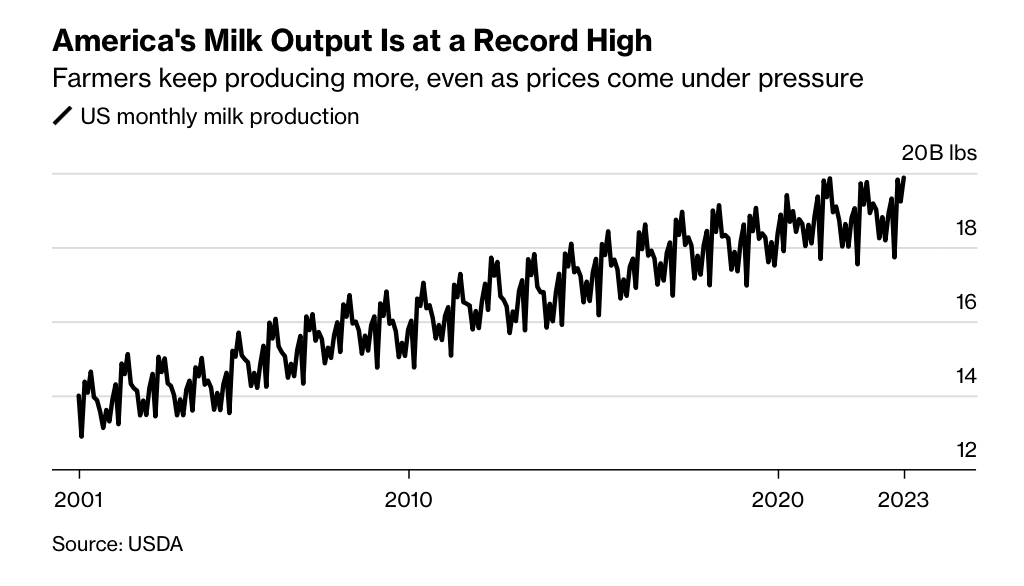Wednesday is WASDE day, when the US government releases its monthly World Agricultural Supply and Demand Estimates report. This time around, all eyes will be on America’s corn yield.
“That’s because 2023 has seen both drought and heavy rains, whipsawing projections for the world’s largest corn crop.
“Futures prices surged in early June as the Midwest wilted, only to erase those gains as record downpours bolstered crop prospects in some areas.”
The Bloomberg article noted that, “Given the recent precipitation, one might expect the Department of Agriculture to lift its outlook, especially since a June 30 USDA report showed farmers planted more acres than analysts expected.
“But the agency moves more slowly than the market, and its painstaking work isn’t expected to fully incorporate the boost from the rains just yet.
“Consequently — and somewhat head-spinningly — the USDA is forecast to reduce its corn-yield view by about 5 bushels per acre to 176.5 bushels, according to the average analyst estimate in a Bloomberg survey.”
Dow Jones writer Kirk Maltais reported yesterday that, “[Monday’s] crop progress report from the USDA showed some upticks in the amount of U.S. row crop acreage in good or excellent condition – but not enough to make traders think that crops are on their way to recovery.”
The article added that, “‘It is unclear whether the USDA will revise U.S. yields in this installment or wait for the traditional on field observations in August,’ said [JPMorgan Global Commodities Research].”
And Reuters writer Naveen Thukral reported today that, “Chicago soybeans rose for a third consecutive session on Wednesday, climbing to a one-week high as a widely-watched U.S. government report due later in the day is expected to reduce its production and supply estimates.”
The article noted that, “‘The market is expecting lower soybean production and supply forecasts from the U.S. Department of Agriculture (USDA) because of dryness and lower planting,’ said one agricultural commodities analyst.
“‘But the weather has improved over the last couple of weeks which has reduced the impact of drought.'”
Thukral added that, “For corn, analysts expect only modest changes to the USDA’s production and 2023/24 ending stocks forecasts, while sluggish demand for the grain remains a worry as farmers in Brazil continue to harvest a bumper corn crop.”
Meanwhile, Bloomberg writers Nazmul Ahasan and Michael Hirtzer reported yesterday that, “There’s more milk than ever in the US but nowhere left to process it, forcing farmers across the Upper Midwest to pour the excess dairy down the drain.”

The Bloomberg article stated that, “As supply rises, processors can’t keep up. About 90% of Wisconsin’s milk is made into cheese, and most of the plants are already filled to the brim. Labor shortages are making the issue worse, said Bob Cropp, professor emeritus and dairy marketing specialist at the University of Wisconsin-Madison. A sudden plant closure in Hastings, Minnesota, earlier this summer due to wastewater issues only exacerbated the issue.

“They’re ‘unable to get other plants to take the milk because they have all the milk they need,’ Cropp said of farmers across Wisconsin and Minnesota.
“As a result, prices for milk are tanking.”
And New York Times writer Linda Qiu reported today that, “The Agriculture Department said on Wednesday that it would establish a monitoring and data collection network to measure greenhouse gas emissions and determine how much carbon can be captured using certain farming practices.
“The network, using $300 million in funding from the Inflation Reduction Act, will help quantify the outcomes of so-called climate-smart or regenerative agricultural practices, a cornerstone of the department’s approach to addressing a warming planet. The research and data that is collected will also be crucial to measuring progress on President Biden’s goal of halving greenhouse emissions by the end of the decade.”
Source : illinois.edu